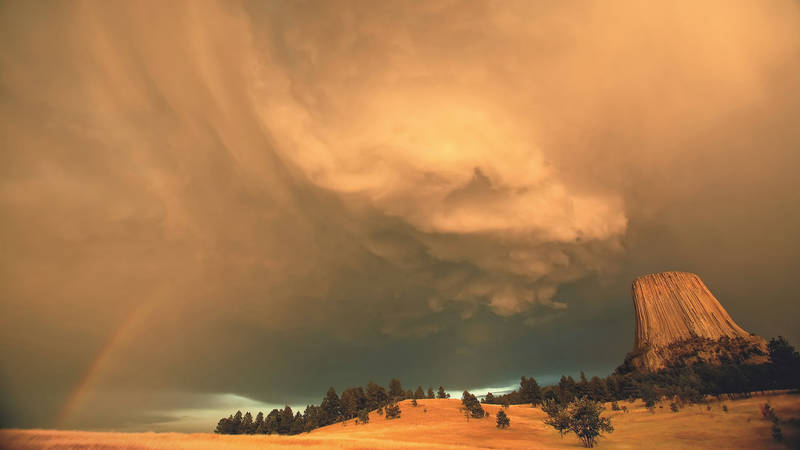Hidden Gems
Devil's Tower National Monument

This fall, NPCA and Travelodge® by Wyndham are calling attention to hidden gems sites within the National Park System that we think are worth knowing more about. From locations rich with history to those with majestic views, we’re taking a closer look at trails, vistas and other lesser-known sites in parks across the country. Protecting public lands is at the heart of what we do and is important to Travelodge as well; we hope by learning more about these lesser-known places, you’re inspired to protect our parks, too.

Devils Tower National Monument
Scientists debate how Devil’s Tower was formed, but agree that about 65 million years ago, molten lava was forced into existing hard rock formations, cooling and eroding over millions of…
See more ›Rising out of the prairie that surrounds the nearby Black Hills, Devil’s Tower National Monument is an astounding geological feature to behold. The tower is known for its sheer size and as one of the best places for rock climbing in North America, and the park is home to sweeping landscapes and a vast array of wildlife and ecosystems.
Closest City: Hulett, Wyoming
Fun Fact: Devil’s Tower is 867 feet from its base to its summit, and its summit is about the size of a football field!
More Than Meets the Eye
While the park’s namesake geological feature is undoubtedly the best-known part of the park, Devil’s Tower National Monument protects more than just the tower itself. The forests and prairies that surround the tower serve as a habitat for deer, elk, pronghorn, foxes and mountain lions, as well as more than 500 plant species. Its location is representative of what scientists call an ecotone: a place where different habitats meet; the forests of the Black Hills, sweeping prairies of the plains, and the swell of the Belle Fourche River are all part of its 1,347 acres.
Hidden Gems in the Park
Did You Know?
Circle of Sacred Smoke Sculpture
While the tower itself dominates much of the horizon for park visitors, the Circle of Sacred Smoke sculpture offers a different perspective, literally and figuratively. The sculpture, designed by Junkyu Muto, honors the American people as a gesture of world peace and was made in recognition of the over 20 affiliated tribes for whom the tower is culturally significant. The sculpture, the first in a planned series of seven, represents the first puff of smoke from a newly lit pipe and frames the tower when viewed from the picnic area. By day, it’s a great place to take in sights; by night, the sculpture marks an optimal spot for stargazing.
Prairie Dog Town
Spanning 40 acres, Devil’s Tower National Monument’s prairie dog town is home to over 600 residents. These animals are the most common prairie dog species in North America: the black-tailed prairie dog. The mammals, a type of ground squirrel, are a keystone species that live in complex tunnel systems. Each tunnel ends in a burrow, single-family units often located near relatives’ burrows. The prairie dog town is part of the Belle Fourche River hub, which can be accessed near the campground with the same name.
Belle Fourche River
Translating to “beautiful fork” in French, the Belle Fourche River (pronounced FOOSH) was also known as the North Fork of the Cheyenne by early explorers. The river has carved through hundreds of feet of sedimentary rock, leaving red sandstone cliffs along its banks. It’s not uncommon to spot deer stopping for a drink in the gentle current of the river; look up and keep your eyes peeled for a chance to see osprey and eagles on the hunt for fish from above. Visitors may fish in the park with proper licenses; lucky anglers have a chance to hook catfish, sunfish and — on rare occasion — walleye.
What People Love About Devil’s Tower National Monument
We asked our followers on social media who have been to the park what they liked best about their visit and what hidden gems people should know about — here’s what they said:
Walking around at night is an incredible experience. It’s so quiet and the tower looming overhead makes it even more special.”
“All of the Indigenous stories about how the tower was formed are so interesting! I’m glad I took some time to learn more.”
“Spending time in the prairie was really cool. The landscape isn’t like anything I’ve experienced back east.
How Can You Adventure Responsibly When Visiting?
-
 Seeing wildlife in person can be exciting, but also dangerous.
Seeing wildlife in person can be exciting, but also dangerous.Give wildlife plenty of room and keep a safe distance during your visit. If wildlife reacts to your presence, you are too close.
-
 Purchase souvenirs from lodges, park stores or local shops
Purchase souvenirs from lodges, park stores or local shopsand leave rocks, vegetation and artifacts where you find them for others to enjoy. Seemingly small objects such as twigs and stones are part of much larger ecosystems that nourish and shelter a range of plant and animal species.
These are just two of the many ways you can ensure you’re adventuring responsibly when you visit a national park site; learn about all 10 Ways to Adventure Responsibly.
Travelodge® by Wyndham Supports NPCA’s Mission
Travelodge® by Wyndham supports NPCA’s mission to protect and enhance America’s National Park System for present and future generations and believes in the importance of preserving parklands. Since 2016, Travelodge® by Wyndham has provided more than $750,000 in support of NPCA and its work to protect public lands. Travelodge’s continued support of NPCA and national parks is complemented by an ongoing commitment to promote eco-friendly travel, aiming to reduce the carbon footprint of over 450 hotels throughout North America with eco-friendly initiatives around breakfast, housekeeping, and bath amenities. Plus, with more than 75 percent of hotels located about an hour’s drive from some of the nation’s most celebrated national parks, Travelodge is your basecamp for adventure. For more information, visit www.travelodge.com/NPCA.
Make a tax-deductible gift today to provide a brighter future for our national parks and the millions of Americans who enjoy them.
Donate Now


